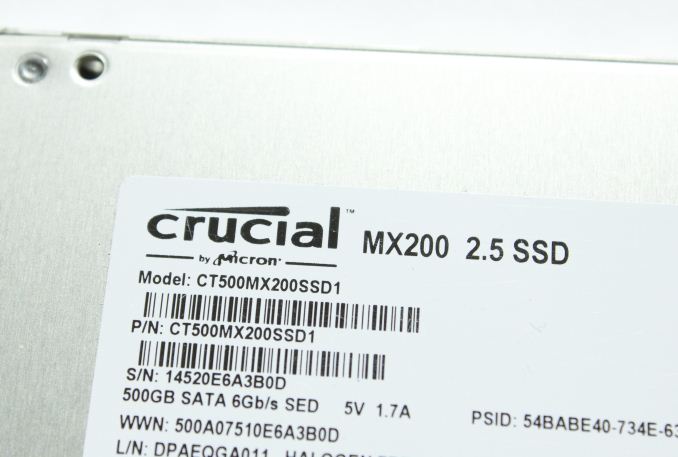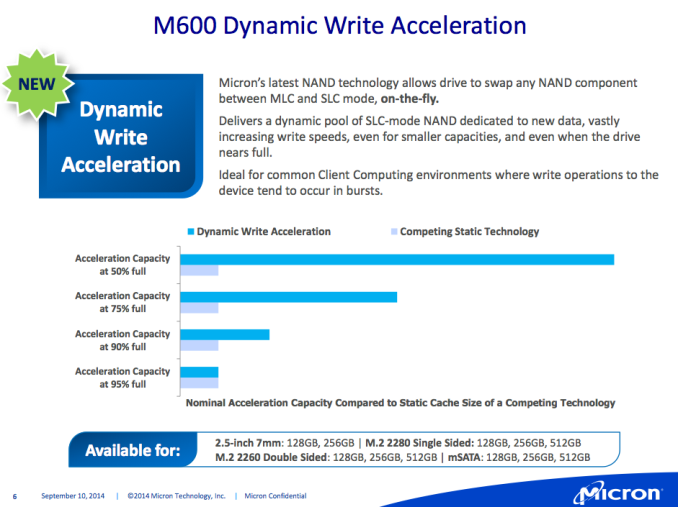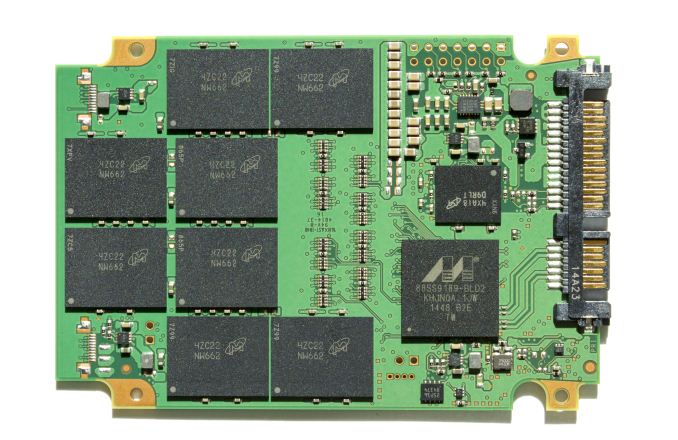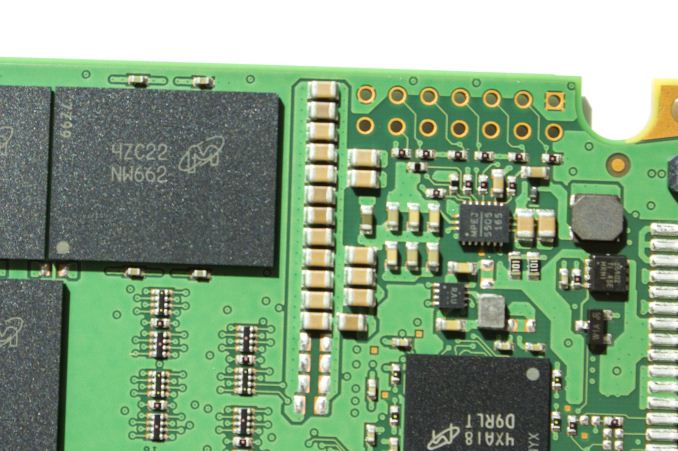Crucial MX200 (250GB, 500GB & 1TB) SSD Review
by Kristian Vättö on May 22, 2015 8:00 AM EST- Posted in
- Storage
- SSDs
- Crucial
- MX200
- Micron 16nm

Last year Micron launched M600 SSD for the OEM market, but unlike in the past there was no simultaneous retail product release. We were told that the M600 firmware features would sooner than later find their way into a Crucial branded product, which finally materialized back at CES when Crucial unveiled the MX200.
The hardware has remained unchanged from the MX100 as the MX200 sports the same Marvell 88SS9189 controller with Crucial-Micron's custom firmware and Micron's 16nm MLC NAND, but the biggest change compared to the MX100 is the addition of Dynamic Write Acceleration (DWA), which is the company's SLC cache implementation. I covered DWA in detail in our Micron M600 review, so I suggest you give it a read if you are interested in a more thorough explanation, but in short the size of the cache is dynamic and varies depending on the amount of data in the drive. Basically, all empty NAND runs in SLC mode, so the size of the cache shrinks as data is written to the drive. I wasn't very satisfied with DWA in the M600 review because it didn't seem to yield any noticeable performance gains, so I hope the engineers have tweaked the caching algorithms for the MX200.
The MX200 is positioned above the BX100 we recently reviewed and liked very much. The CES announcement signaled a change in product strategy because previously Crucial has more or less had just one main product line, but with BX100 and MX200 Crucial is trying to cater a larger segment of the market by offering the BX100 for the mainstream public and the MX200 for the more demanding enthusiast/professional user group.
| Crucial MX200 Specifications | ||||
| Capacity | 250GB | 500GB | 1TB | |
| Form Factors | 2.5" 7mm, mSATA, M.2 2260 & 2280 | 2.5" 7mm | ||
| Controller | Marvell 88SS9189 | |||
| NAND | Micron 16nm 128Gbit MLC | |||
| DRAM (DDR3-1600) | 512MB | 512MB | 1GB | |
| Sequential Read | 555MB/s | 555MB/s | 555MB/s | |
| Sequential Write | 500MB/s | 500MB/s | 500MB/s | |
| 4KB Random Read | 100K IOPS | 100K IOPS | 100K IOPS | |
| 4KB Random Write | 87K IOPS | 87K IOPS | 87K IOPS | |
| Dynamic Write Acceleration | Yes | Yes (mSATA and M.2 models only) | No | |
| DevSleep Power | 2mW | 2mW | 2mW | |
| Slumber Power | 100mW | 100mW | 100mW | |
| Max Power | 4.4W | 4.7W | 5.2W | |
| Encryption | TCG Opal 2.0 & IEEE-1667 (eDrive) | |||
| Endurance | 80TB | 160TB | 320TB | |
| Warranty | Three years | |||
| Crucial MX200 | $110 | $200 | $427 | |
The MX200 is available in a variety of form factors, which includes rarer double-sided M.2 2260 and single-sided M.2 2280 on top of the normal 2.5" and mSATA models. Due to PCB space restrictions in mSATA and M.2 form factors, only the 2.5" lineup carries a 1TB SKU and the mSATA and M.2 models top out at 500GB. The 2.5" SKUs also include an Acronis True Image HD license and 7mm to 9.5mm spacer to ensure laptop compatibility, whereas the mSATA and M.2 retail packages have only mounting screws in addition to the drive itself. All MX200 models are compatible with Crucial's Storage Executive software, which we covered thoroughly in the BX100 review.
| 250GB | 500GB | 1TB | |
| Raw NAND Capacity | 256GiB | 512GiB | 1024GiB |
| # of NAND Packages | 8 | 8 | 16 |
| # of Die per Package | 2 | 4 | 4 |
| Over-Provisioning | 9.1% | 9.1% | 9.1% |
The MX200 includes a bit more over-provisioning than its predecessor as Crucial has decided to switch from power of two capacities to even tens/hundreds. A part of the over-provisioning is dedicated to Micron's NAND-level parity scheme called RAIN, but the rest is used as additional provisioning to increase stead-state performance as well as overall endurance.
Endurance wise the MX200 is one of the top drives on the market. Whether the extra endurance is needed is another question, though, because the 320TB rating in the 1TB model would translate to 175GB of writes per day for five years, which is far more than what most power users write to a drive on a daily basis, let alone a typical client user. Since Dynamic Write Acceleration is only enabled on the 250GB model (although 500GB mSATA and M.2 models have DWA enabled), the high endurance comes purely from Crucial's longer validation, although obviously Crucial has access to the best NAND dies given that its parent company Micron manufactures the NAND. Oddly enough the warranty is only three years as it would make sense offer longer warranty with such a high endurance rating and nearly all high-end SSDs today offer either five or ten year warranties.
Aside from higher endurance and supposedly better performance, the key differentiator to BX100 is the support for hardware-accelerated encryption in the form of TCG Opal 2.0 and IEEE-1667 standards that together enable the use of Microsoft eDrive. Crucial was an early supporter of the standards and first implemented them into the M500 two years ago, so they have now become a part of the common Crucial feature set, although the BX100 dropped the support for higher cost efficiency. It seems that Crucial has taken a strategy to guide the corporations that require hardware encryption towards the more expensive MX200, which is what many SSD companies have been executing in the form of a separate "business SSD" lineup.
The ceramic capacitor array in the 1TB MX200
In the M600 review, I explained how Crucial's power loss protection in client SSDs is not the same as in enterprise drives, but a backup circuitry that merely protects the existing data from corruption. The MX200 brings no changes to that and only offers data-at-rest protection, meaning that the NAND mapping table as well as any in-flight user data are still vulnerable to sudden power losses.
| AnandTech 2015 SSD Test System | |
| CPU | Intel Core i7-4770K running at 3.5GHz (Turbo & EIST enabled, C-states disabled) |
| Motherboard | ASUS Z97 Deluxe (BIOS 2205) |
| Chipset | Intel Z97 |
| Chipset Drivers | Intel 10.0.24+ Intel RST 13.2.4.1000 |
| Memory | Corsair Vengeance DDR3-1866 2x8GB (9-10-9-27 2T) |
| Graphics | Intel HD Graphics 4600 |
| Graphics Drivers | 15.33.8.64.3345 |
| Desktop Resolution | 1920 x 1080 |
| OS | Windows 8.1 x64 |
- Thanks to Intel for the Core i7-4770K CPU
- Thanks to ASUS for the Z97 Deluxe motherboard
- Thanks to Corsair for the Vengeance 16GB DDR3-1866 DRAM kit, RM750 power supply, Hydro H60 CPU cooler and Carbide 330R case













62 Comments
View All Comments
RAMdiskSeeker - Sunday, May 24, 2015 - link
Would you be able to re-run and publish the benchmarks for the MX200 250GB drive formatted as a 100GB drive so that it runs entirely in SLC mode?jihe - Monday, May 25, 2015 - link
No way would I recommend Samsung to anyone. Selling TLC for the price of MLC? Massive lost of performance?pseudoid - Wednesday, May 27, 2015 - link
Thank you for yet another great SSD review.I am from the old-skool camp when eeking out performance from drives meant the only alternative was SCSI drives spinning at 10k RPM and when SCSI cables cost more than the current 128GB SSDs. I gradually stepped up to VelociRaptor HDDs that were the only performance champs leaving behind SCSI HDDs and waiting for SSDs to get to affordable range. Yet those VelociRaptors are refusing to die in my system after all these years.
A few years ago, I finally broke down and bought a Patriot Pyro 240GB as my current Win8.1Pro OS boot drive (all user data are directed to the older VelociRaptors to afford longevity to the Patriot Pyro).
I use a utility called SSDLifePro (http://ssd-life.com) to periodically monitor the performance of my Patriot Pyro. It currently tells me the following info:
READs = 27TB >> WRITEs = 15TB
Energized Time = 23,635Hours (2yrs, 8mos,14days)
Power Cycles = 609 times
Estimated Lifetime = 6yrs, 11mos >> End Of Life = April 2022
No, the above info is not for neener-neener, but strictly as a pre-amble to the following question:
Why are Patriot (Ignite series) SSDs never discussed (or reviewed) in AnandTech?
Ditto for Intel SSDs??
NvidiaWins - Thursday, June 4, 2015 - link
Crucial made the list of failing SSD's drives last week-read- http://www.extremetech.com/computing/173887-ssd-st...
NvidiaWins - Thursday, June 4, 2015 - link
Smart people buy Intel, Intel SSD's don't fail, ever.You see that Intel is considered the only reliable SSD manufacturer-
http://www.extremetech.com/computing/173887-ssd-st...
Arkadius - Wednesday, August 5, 2015 - link
Can You retest MX200 250GB with new firmware MU02?MU02 Crucial MX200 SSD (all form factors)
Release Date: 07/14/2015
Improved Read Performance on small address spans
Improved Random Write performance on transfers not aligned to 4KB address boundaries
Improved Acceleration Capacity Recovery after TRIM and SANITIZE commands
Added Informative SMART thresholds for Attributes 202 and 5
Added Support for READ DMA BUFFER, WRITE DMA BUFFER, and DOWNLOAD MICROCODE DMA Commands
Bug Fixes and Stability Improvements
http://www.crucial.com/usa/en/support-ssd-firmware
Resental - Sunday, December 27, 2015 - link
Quote, I just bought a MX200 250GB, I have obtained much better results then those in this article, maybe they solved with latest firmware.Scott.deagan - Monday, August 24, 2015 - link
I just purchased a Crucial MX200 500GB for my Dell M3800 laptop (Ubuntu edition). I need drive encryption for work. Have only been using it for a day so far, but am loving it. I'm not that fussed about performance issues between different SSD drives, all I know is this SSD is so much faster than the spin drive that came with the M3800. It feels like a new machine.Thanks for the review. Very informative. I'll check out the 850 EVO for my personal laptop.
drSeehas - Saturday, October 17, 2015 - link
"DRAM (DDR3-1600) 512 MB" for the 250 GB drive. Are you sure?Firedrops - Saturday, February 13, 2016 - link
Please show us actual capacity on storage device reviews! These things vary too much from manufacturer to manufacturer, a drive labeled 480gb is often easily over 20gb smaller than one labeled 512gb in true capacity.